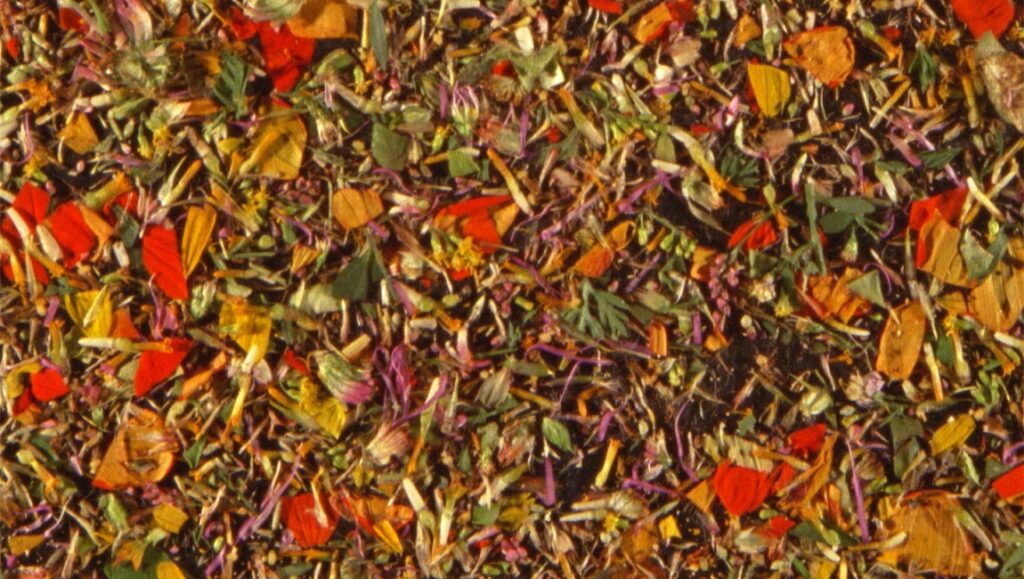Experimental animator Jodie Mack is likely best known for her 2018 magnum opus, The Grand Bizarre — a remarkable film that connects handmade textiles to globalized markets. But Mack has also long focused on more intimate, smaller-scale projects. These films, most significantly shorter than the near-feature length Bizarre or Dusty Stacks of Mom (2013), tend to organize various objects into frenetic montages of perception-bending movement while blurring the lines between animation and pure abstraction. Whether investigating a mineral collection (2018’s Hoarders Without Borders), discarded circuit boards (2017’s Wasteland No. 1: Ardent, Verdant), or her own garden (2019’s Wasteland No. 2: Hardy Hearty), Mack has a recurring fascination with the detritus of the world.
In a 2021 interview with Robert Delany, Mack said, “I think a lot about the idea of resuscitation when thinking about materials that are discarded… I’m working a lot with plants now and the cycles of them, and their roots, and their dead leaves. And when you garden, you realize that everything is useful… definitely every object has a life to be invigorated or a previous function to be celebrated or eulogized.” Perhaps counterintuitively, very recent works like A Deserted Farm and Lilly (both 2022) feel like exploratory sketches, test runs even, that focus on turning the body itself into discrete units of information — a “potential object,” in Mack’s words — as stuttering frames juxtapose the same face and figure (Mack’s own, in fact) in alternating directions: up and down, left and right. But these various concerns all coalesce in M*U*S*H*, wherein Mack utilizes the same frame-by-frame technique to construct eight minutes of blisteringly fast photography that transforms piles of foliage into an optical cornucopia of colors and shadows. By turns reminiscent of Tony Conrad’s The Flicker and the handmade collages of Stan Brakhage (particularly Mothlight), M*U*S*H* gives a corporeal shape to phenomenological sensations.
It’s not entirely clear, to this viewer, how Mack actually made this film (a behind-the-scenes making-of would be revelatory). Writing about M*U*S*H* in 2022, InRO contributor Michael Sicinski suggested the use of the above-mentioned frame alternation, although it’s unspecified if it is a physical or digital process. Regardless of the exact technique, M*U*S*H* emphasizes color above all else: dark browns and yellows, reds and greens, purple, lavender, umber, and ochre patches flit across the screen at a dizzying clip, barely giving the eye a chance to register what it’s seeing. Mack intermittently inserts very brief pauses that give the viewer a chance to orient themselves, while revealing that the colors are actual objects — in this case, foliage of various sizes and shapes that have been scattered onto a white background. Presumably a chance operation (there’s no indication that the foliage has been arranged in any particular way), the objects cast a shadow onto the background, creating an almost stereoscopic sensation as the colors and their shadows alternate back and forth, back and forth. Like a Pollock drip painting come to life, the small objects, these brittle leaves, appear to disperse and then reassemble, alternating in density from sparse to overcrowded. It’s a pulsating, undulating image, always changing in front of your eyes. Fred Camper has referred to Brakhage as a “documentarian of subjectivity,” a poetic notion that also applies to Mack. Finding inspiration in the quotidian, the discarded, the old, Mack rearranges these into something new and vivacious. The crinkled leaves of plants are the ultimate found material, organic but also in the process of drying out and dying. Here they are revived, recontextualized, even resurrected into a blast of abstraction.
Published as part of InRO Weekly — Volume 1, Issue 18.


Comments are closed.